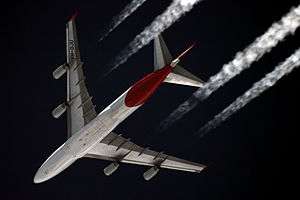Cruise (aeronautics)
Cruise is a flight phase that occurs when the aircraft levels after a climb to a set altitude and before it begins to descend. [1]

Cruising usually consumes the majority of a flight, and it may include changes in heading (direction of flight) at a constant airspeed and altitude.
For most passenger aircraft, the cruise phase consumes most of the aircraft's fuel. This lightens the aircraft and raises the optimum altitude for fuel economy. For traffic control reasons it is usually necessary for an aircraft to stay at the cleared flight level. On long-haul flights, the pilot may ask air traffic control to climb from one flight level to a higher one, in a maneuver known as step climb.
Cruise speed
Commercial or passenger aircraft are usually designed for optimum performance at their cruise speed (VC). Combustion engines have an optimum efficiency level for fuel consumption and power output.[2] Generally, piston engines are most efficient between idle speed and 25% short of full throttle.[3]
With aircraft, other factors affecting optimum cruise altitude include payload, center of gravity, air temperature, humidity, and speed. This altitude is usually where the higher ground speeds, the increase in aerodynamic drag power, and the decrease in engine thrust and efficiency at higher altitudes are balanced.
The typical cruising airspeed for a long-distance commercial passenger aircraft is approximately 880–926 km/h (475–500 kn; 547–575 mph).
See also
References
- "Glossary". CAST/ICAO Common Taxonomy Team. Retrieved 2016-06-19.
- Cruising speed definition
- Idle speed mentioned as most efficient in some cases, up to 75% of full throttle; or 3600 rpm for gasoline engines